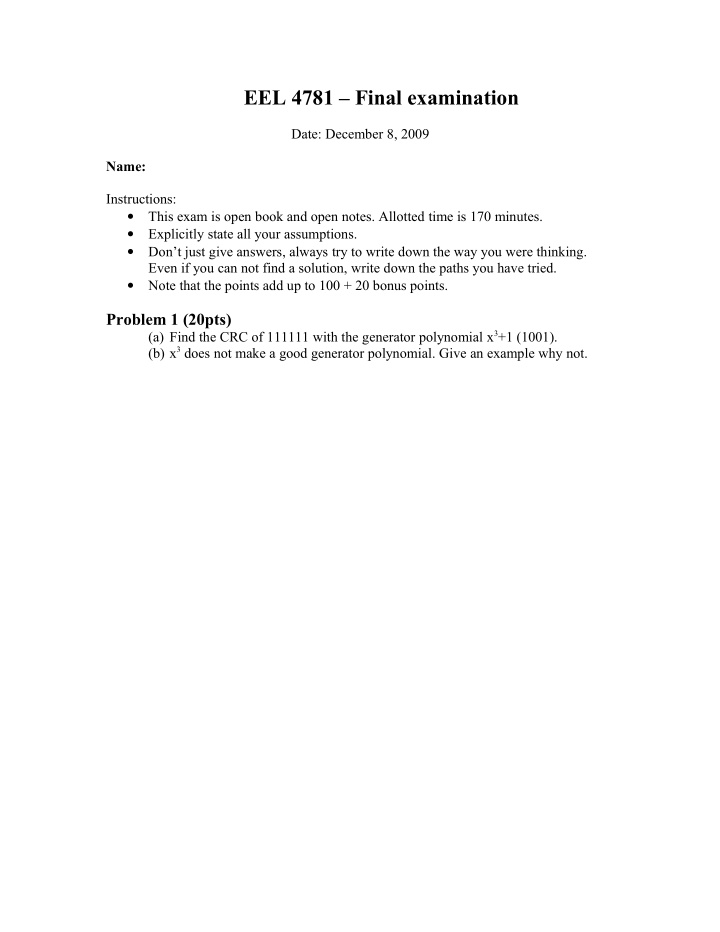



EEL 4781 – Final examination Date: December 8, 2009 Name: Instructions: • This exam is open book and open notes. Allotted time is 170 minutes. • Explicitly state all your assumptions. • Don’t just give answers, always try to write down the way you were thinking. Even if you can not find a solution, write down the paths you have tried. • Note that the points add up to 100 + 20 bonus points. Problem 1 (20pts) (a) Find the CRC of 111111 with the generator polynomial x 3 +1 (1001). (b) x 3 does not make a good generator polynomial. Give an example why not.
Problem 2 (20pts) PassTheBuck is a local area network protocol, similar in purpose to Ethernet, but based on different principles of mediating access to the bus. To mediate access to the bus, PassTheBuck uses a dollar passing scheme. When peers are inactive, a single dollar message is passed around the network from machine to machine, and no peer is allowed to use the bus unless it has the dollar. If a particular peer wishes to send a message, it waits to receive the dollar, sends its message, and then passes the dollar on to the next station. (a) Let us consider maximum physical network size. Can we put the PassTheBuck network on longer cables than Ethernet? Why? (b) Can you have collisions on the PassTheBuck network? Why? (c) PassTheBuck can provide a more fair allocation of bandwidth than Ethernet. Yes/No, why? (d) PassTheBuck can handle high load better than Ethernet. Yes/No, why?
Problem 3 (20pts) A router has the following CIDR entries in its routing table: Address/Mask Next hop 122.16.11.0/22 Interface 0 122.16.0.0/21 Interface 1 192.168.1.0/23 Interface 3 Default Interface 4 For each of the following IP addresses, what does the router do if a packet with that address arrives (a) 122.16.11.3 (b) 122.16.5.3 (c) 135.46.52.2 (d) 192.168.1.45
Problem 4: (20pts) Our IP addresses are attached to machines (more exactly network cards). As the ultimate consumer of the network packets needs to be a process, the port numbers in UDP and TCP allow us to separate the communications which are coming to the same machine but different processes. Somebody proposes the extended IP address, which is composed of the IP address followed by the process id: 1.2.3.4.6000 would address process 6000 on the machine 1.2.3.4. Give four reasons why this is a bad idea.
Problem 5: (20pts) Suppose that for a TCP connection, the maximum segment size is 1KB (this is the smallest size of the congestion window). Currently the TCP congestion window is set to 8KB and the threshold is 5KB. Trace the size of the congestion window and the threshold for the following sequence of events: timeout, success, success, success, success, success, succcess, timeout
Problem 6: (20pts) (a) Outline a way to steal somebody's private data if you can tamper with his DNS server. (b) Outline a way in which the companies can figure out that user “will” at Tiger's Golf and user “bill” at Teddy's Bears map to the same person. (c) Outline a way in which Google can figure out that “will.johnson@gmail.com” and “john.wilson@gmail.com” are (1) roommates or (2) the same person. (d) Outline a way in which Google can figure out that you are associated with UCF (assume you have a Gmail address).
Recommend
More recommend